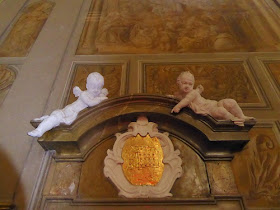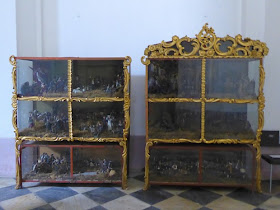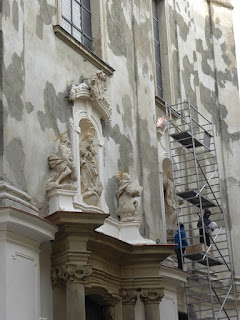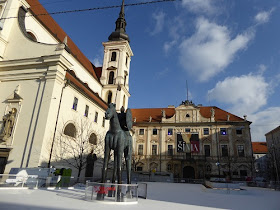Enter any one of the Catholic churches in the centre of Brno and you feel like you're in Italy. There always seemed to be quite a few folk engaged in quiet prayer, both young and old, when there weren't services at various times of the day during the week. Unquestionably the most fascinating, if not the most harmonious - that distinction belongs to S. Jakub (James), detail from the16th century pulpit of which I've pictured, for obvious seasonal reasons, above - is the doubly holy Minorite Church of St John and Loreto in Minoritska Street.
I mistook the main interior for the Jesuit Church, so rich in baroque decoration is it (by Johan Georg Schauberger and Johan Georg Etgens).
The chief lure, though, is the Loreto Chapel which you might miss if you didn't push at a door on the north side of the main church. It needs to be almost as large to house a replica of the Virgin and Child's flying abode of the Virgin which landed in said Italian town (we visited on a tour of the Marche some years back). There's a reproduction of Loreto's black Madonna on the altar within
and grisaille depictions of the miracle on the outer walls
as well as another depiction of the casa santa held by putti.
I don't know whether the cabinets of crib/presepe scenes and figures only come out before Xmas,
but they're of some curiosity, including handsomely clad Three Kings and entourage.
The east end is even more extraordinary than the reproduction holy house: an emulation of the Scala Santa, the 28 marble stairs in Rome's San Giovanni in Laterano, themselves an emulation of the Jerusalem steps on which Christ stood while being led to Pilate, traditionally ascended by pilgrims on their knees.
Schauberger's statue line this one, with fine crucifixion figures above the arch,
and apart from the old sacristan lady who followed me around, a solitary pilgrim was the only other person I encountered here.
And so back through the door with an elaborate virgin and child above it,
to the west end and organ
while a much smaller mechanical 'instrument' - I thought from Tchaikovsky's descriptions of his childhood it might be an orchestrion - was wielded by a Santa-like gentleman outside
whose wound-up merry tones had kept me company as I wandered around church and Loreto chapel, a nice antidote to the cult of suffering.
Work was being done on the main facade
and St Joseph further down the road was completely under scaffolding. But most other churches were open for business, including the very homely St Mary Magdalene, purportedly on the site of a synagogue in what had been the Jewish quarter. The first church I 'hit' every morning on the walk from my hotel to the north was S.Tomáš, with the spire of S Jakub beyond.
S. Tomáš, on the site of an Augustinian monastery, was closed except on one evening where the skating rink which looked so promising to the side of the church and in front of the Moravian Gallery
took off for action one very lively evening.
This time the very loud pumped music was no help to reflection within, though I liked the interior in semi-darkness, even if that meant I couldn't see its greatest treasure, Henricus Parlerius's Pietà of c.1385. On a sunny morning, though, the Gothic glory of S Jakub shines bright indeed.
The pulpit is on the left. The three stone reliefs - Nativity, Jesus in the Temple and on the Mount of Olives (or appearing on Tabor, according to whom you read) - date from 1526, the wooden transverse canopy from 1684.
There are plenty of other fine treasures - a northern Italian polychrome crucifix from the late 13th century,
lavishly carved pews of 1707, one set on each side of the main altar,
and the tomb (1718-27) of Louis Raduit de Souches, commander of Brno's defence against the overwhelming numerical superiority of Swedish forces in 1645.
Precious or not, the work on this door struck me as rather lovely.
Just round the corner is the Jesuit Church, where a service was going on, so I merely stood at the back
but did manage to observe this interesting chapel
with its oriental figures.
More than that I can't say, nor discover on the internet. What I do know is that the Jesuits came here in 1578, had the church completed in four years and the attached college in 50. Both served their purpose until 1773, when Joseph II dissolved the order. The whole college complex was pulled down in 1904, paving the way for some of the grandest apartment blocks in Brno on Dvořákova Street.
The Jesuits are back in control of the church now (they even wear leather jackets these days),
and welcoming the three wise men, in seasonal central European style, on the door.
This time, I didn't get to see the interior of the Cathedral of SS. Petr and Pavl on Petrov hill, though it seems to have had an unimpressive makeover. The steeples make it an attractive landmark, even though they're neo-Gothic, dating from 1901. From the Vegetable Market which was housing one of four major Christmas fairs in the centre
and from below,
as I walked towards the City Cemetery to pay homage at Janáček's grave - a long walk, though if I hadn't undertaken it I would have missed the fine Church of St Leopold across Brno's negligible river,
remarkable not so much for its interior, which I saw only through glass, but for the old pharmacy, still fulfilling its original function.
The cemetery has plenty of interest, but its other most celebrated inhabitant is Joseph Mendel the father of genetics, buried in the plot of the Augustinian monastery where he lived and taught.
The monastery was my main objective on the afternoon of my tour of 'functional' architecture in the north of the city. I arrived at sunset, and as promised the14th century Basilica of the Assumption of Our Lady was the grandest edifice in the city, externally at any rate.
The so-called 'royal' or 'Queen's' monastery was founded as a Cistercian convent in 1323. Joseph II ordered the Augustinians to move here from S. Tomáš in 1783.
At the entrance to the Mendel Museum, I bumped into folk I already know from the Habsburg Tour group (one of them, my student Robin Weiss, thinks his grandfather was taught by Mendel). They'd just had a guided tour of the monastery buildings - the only way to see the old Library and the inside of the Basilica. And as numbers for these tours have to be plentiful, I missed my chance; the first I could join would be after my departure.
How kind, then, of Eva on the desk, pictured above on the right, with her historian colleague, to unlock the church for me. Eva is a genetics student from the city's Masaryk University currently doing her PhD on the bones in the crypt of S. Jakub, and she was such nice company. I think I enthused them both about why they should go and see Janáček's operas; I found myself getting quite emotional in talking about them. Couldn't see a great deal of the Baroquicisation inside the theatreas it was dark with only a few lights to be found, but enough to sense the grandeur of the pillars and the general nobility of the building (no photos).
The public can attend the daily evensongs, but I couldn't stay for the one that day, alas. There are currently only three monks in residence, none of them Czech; what will happen, I wonder? Certainly the monastery was thriving, after its fashion, when Mendel made his experiments with pea-pods grown in the front garden and Janáček was sent here to board, as the musical child of a poor family, in the late 19th century. He had a rather melancholy time here, but did immortalise his time as a scholar in the 'March of the Bluebirds' movement of his Mladi (Youth) Suite for wind sextet (the boys were called 'Bluebirds' because of their uniform). Here it is, followed by the finale of the suite, as played by a top line-up of wind players including my idol as an oboist, Maurice Bourgue.
A plaque on an outside wall of the basilica is the commemoration of the piece and of Janáček's time here.
By the time of my tour and much time spent absorbing the excellent audio-visual displays of the Mendel Museum, which also houses his original, groundbreaking manuscript,
it was dark, the basilica nicely lit up.
My last glimpse of the Monastery was from above, on the bitterly cold (-6) last morning of my stay, when I walked up the Špilberk hill and around the edge of the castle with its grim history. Beyond the walls are the exhibition grounds, the first buildings dating from 1928 - another place I'd like to have had time for.
From the castle gardens, which must be a wonderful asset for citizens in the spring and summer, there's also a fine view of the Cathedral.
Impressive city - I'm waiting, as Janáček's Fox and Vixen put it, 'until next May comes' to return.












































So Brno is clearly filled with treasures, old and new. I admire the way you take as full advantage as possible of every place you visit in the limited time you often have. Here, certainly, in a very short time, you covered a lot of ground, even in the bitter cold! The St. Jakub light-filled interior is particularly striking. Happy holidays to you and J!
ReplyDeleteYes, I completely fell in love with the place: something very real about it, as I said before, while the centre of Prague, beautiful though it essentially is, has fallen to all the tackiest aspects of mass tourism. But there are so many other smaller Czech towns worth seeing, too, and I haven't done more than explore the tip of the iceberg there. Happy hols to you both, too.
ReplyDeleteYes but what has happened to Prague has happened all over the world - Versailles, the Roman Forum, the Sistine Chapel, and I suppose Angkor Wat around which they have built so many hotels. And look at the size of the cruise ships approaching Venice and other ancient places. But what can be done? Only allowing in tourists who have passed a test set by Nice and Damant?
ReplyDeleteIt is in the smaller towns in the Czech lands that one can feel the atmosphere, as you say. Two points occur to me. First the communist rule for 45 years, terrible in many ways, did protect Czechoslovakia from modern rebuilding in the tedious style of the 1960s -1980s. Secondly, as I drove through the villages of Moravia and Bohemia in 1968 I saw chickens running wild. I mentioned this to my Czech hosts in Prague, and said that the chickens would be very tasty. " O no" they replied" we don't eat dirty chickens like that, ours are brought up in nice clean cages."
Well, regulations for a start: no cruise ships allowed into Venice (corrupt Italian legislation is responsible for that), no tacky chainstores in the centre of Prague, no monocycles or mass scooters (the latest substitute in Prague, I gather), no building around sacred sites (since I visited Petra, a dirty great big Movenpick has sprung up by the entrance). Unfortunately communist rule did not prevent much insensitive rebuilding in Czech towns and cities, though there was less knocking down, I think.
ReplyDeleteOnce again you take me on your travels and give me a glimpse at things I would not otherwise encounter. As always your word and photos brought things to life. Many thanks.
ReplyDeleteThat pharmacy reminded me of a visit we made during our time in Rome to La Farmacia di Santa Maria della Scala. It sent me back to find the post I wrote on it at the time. Unfortunately it was now only a historical site not a working pharmacy.
I hope you and J. had a happy Christmas?
Season's greetings to you, Will and Laurent. There's a famous Antica Farmacia in Florence, isn't there, but I see that its much-exported products all use chemicals the monks would abhor. Nice one in Tallinn's main square, too. Good to see more of Lisbon through your eyes. Happy travelling in 2019 - time for you to visit us here.
ReplyDelete